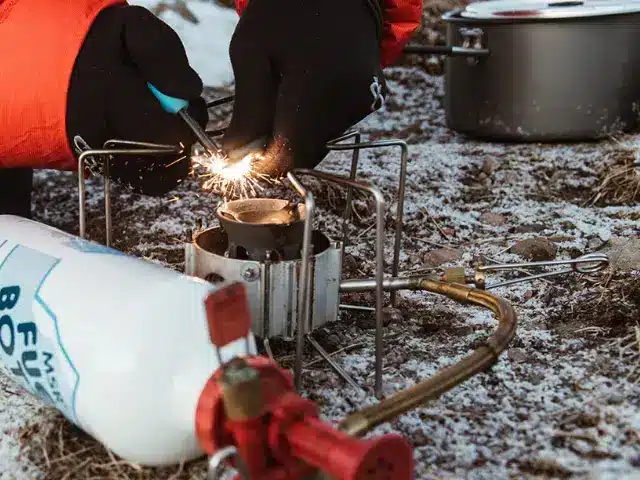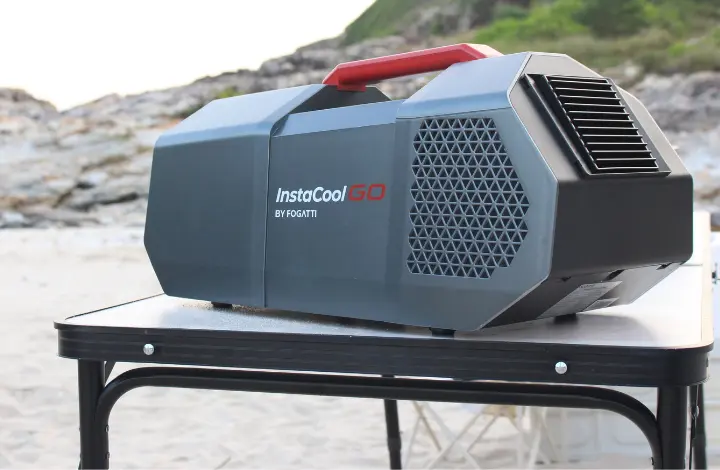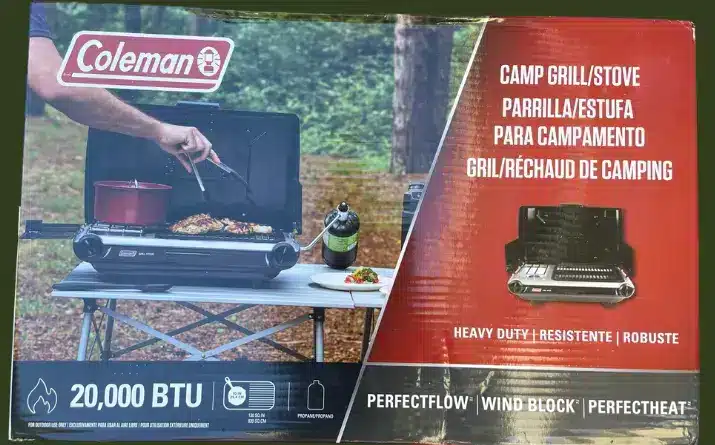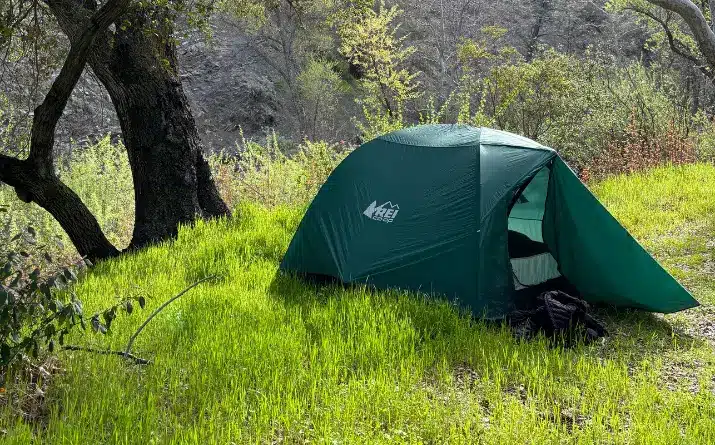The 6 Best Camping and Backpacking Stoves
The world of camping equipment has seen a massive influx of ingenuity over the past few decades. Everything from tents to eating utensils has gone through changes that make the experience of living in the wilderness more and more pleasant. Perhaps the most important tools that have been revolutionized in recent years are camping and backpacking stoves.
Camping and backpacking stoves come in a wide variety of shapes and sizes, each with different features that make them special. With so many options, it can be hard to figure out which stove best suits your needs in the outdoors.
To remedy this, I have done my research, tests, and solicited feedback from outdoor enthusiasts. Below is a comprehensive guide for choosing your ideal camping stove.
We will take a look at every category of camping stoves, addressing the pros and cons of each one, and then providing a recommendation that falls within that category.
From lightweight backpacking stoves to multi-burner “picnic table” stoves, there are options out there for every use case.
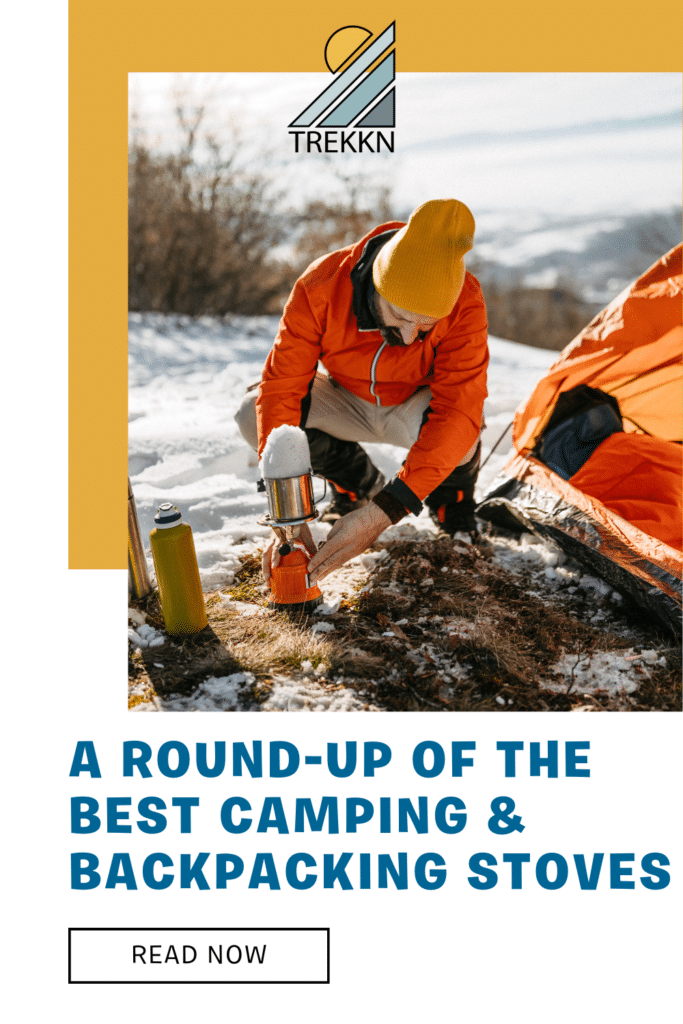
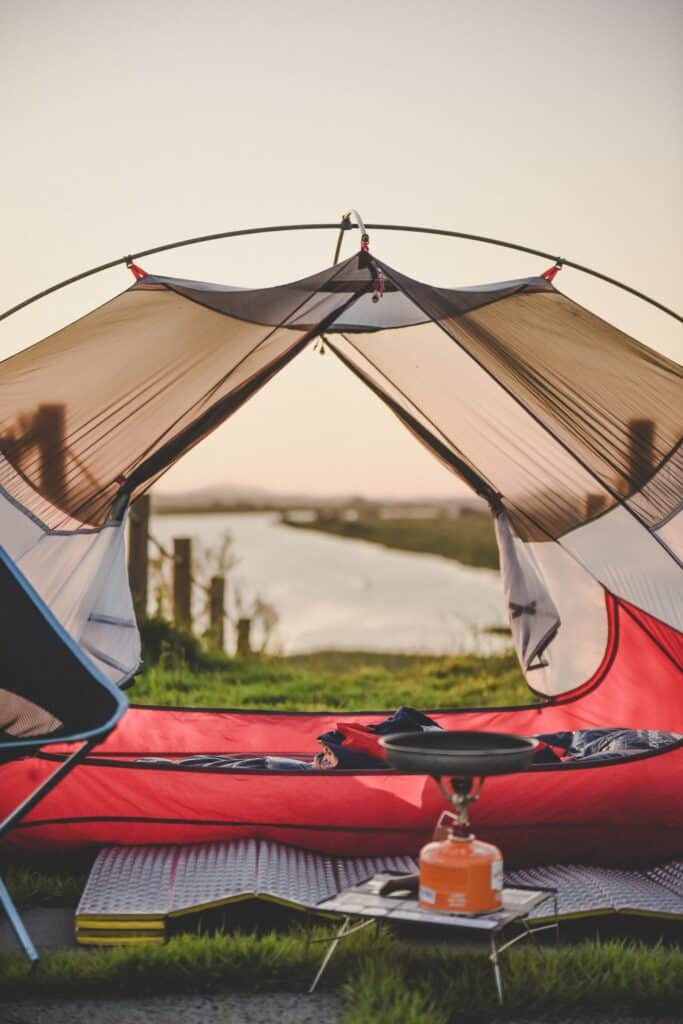
Things to Consider When Shopping for Outdoor Stoves
Before diving into the specifics, let’s take a quick look at things to consider when searching for that perfect stove.
How and Where You Will Use It
When choosing which camping stove is best for you, one of the most important deciding factors is how you plan to use the stove.
Cooking for a family of five in the front country will not work too well if you have a lightweight, single-burner backpacking stove. Just as lugging a 9-pound two-burner stove for 12 miles on the trail will not produce the best experience.
Before anything, figure out how many people you want to be able to cook for and where you want to cook (front- or back-country?).
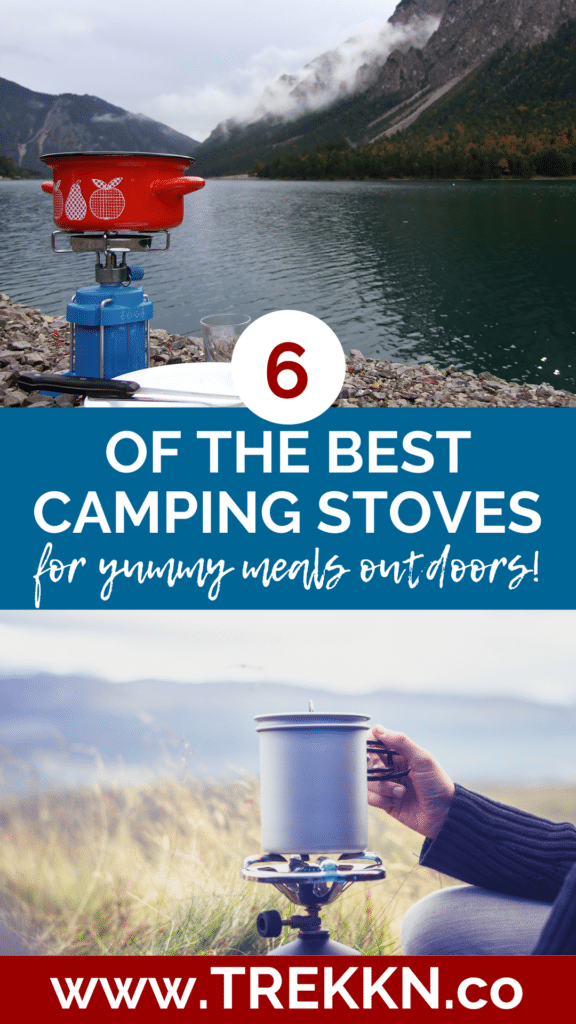
Fuel Source
Different categories of stoves use specific types of fuel. As with most products, there are pros and cons to each one.
For example, a tabletop stove will most likely run on propane. Propane is available at many gas stations, hardware stores, and some convenience or grocery stores. It comes in different size containers and performs well in most conditions.
By comparison, a backpacking stove typically runs on lightweight isobutane. You can purchase isobutane canisters at certain sporting goods stores.
As we go through our roundup of the best camping and backpacking stoves, we will look more closely at the pros and cons of each fuel type.
Specs and Features
Camping and backpacking stoves are not all created equal. Paying attention to certain factors such as weight and the average time it takes to boil water can help you find the right fit.
You may be looking for a stove that simply boils water as quickly as possible. Or maybe the ability to effectively simmer suits your needs a bit better. Whatever the case, there is a camping stove out there for you.
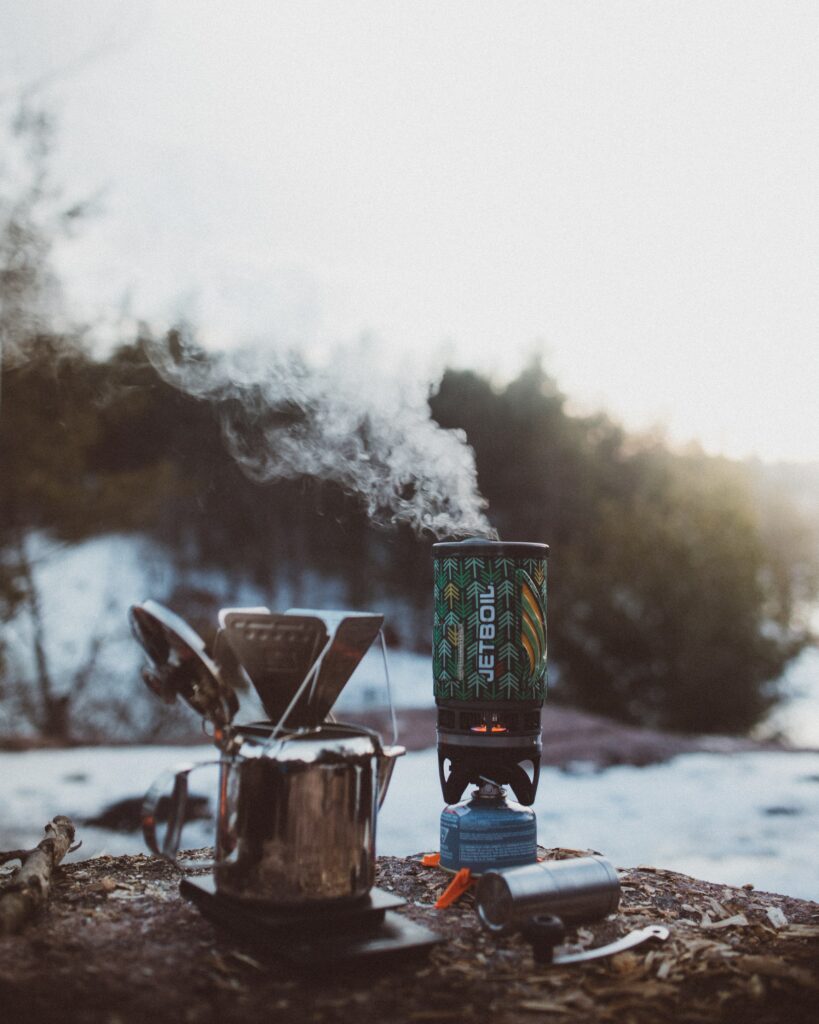
So, if you’re ready to get cookin’ in the great outdoors, let’s dive into the best camping stoves on the market.
The 6 Best Camping & Backpacking Stoves
1. Gas Stoves
Two-Burner Propane Fuel
When you think of a classic front-country camping stove, you most likely picture a two-burner propane stove. Made popular by brands like Coleman, this category of camping stove excels at feeding larger groups of people.
If family camping trips are in your future, a two-burner propane stove is probably what you’re looking for.
The fact that these kinds of stoves run on propane makes them very convenient. Propane is a liquefied petroleum gas that is easily found all over the U.S. and a number of other countries.
A consumer can purchase propane in a variety of vessels, including small canisters that are easily portable, and large tanks that will last for quite a while.
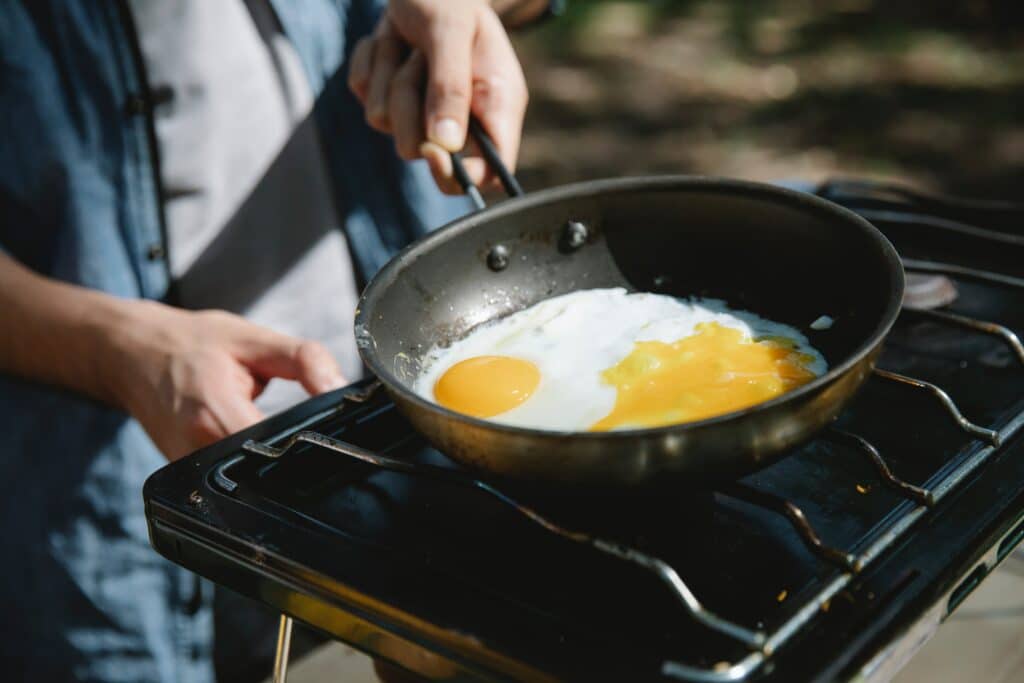
Efficient and Durable
Two-burner propane stoves are fairly reliable options that perform well in average conditions. A 100% propane canister will burn much faster and less efficiently in extreme cold. (We will talk about better options for extreme temperatures a little later.)
These stoves are also rather durable. They are typically made out of strong materials such as steel. However, the durability and large size of two-burner stoves come at a price: weight.
This category of camping stove typically weighs ten pounds or more, making it a less-than-ideal option for lugging around on your back. They are better suited for car camping or camping spots that don’t require much walking.
Pros of Propane
- Typically has two burners
- Excels at feeding large groups of people
- Runs on readily available propane tanks
- Durable and fairly reliable
Cons of Propane
- Not ideal for extreme temperatures
- Weight adds up quickly
- Only a good option for car camping and/or front-country camping
The Best Two-Burner Camping Stove: Camp Chef Everest 2X
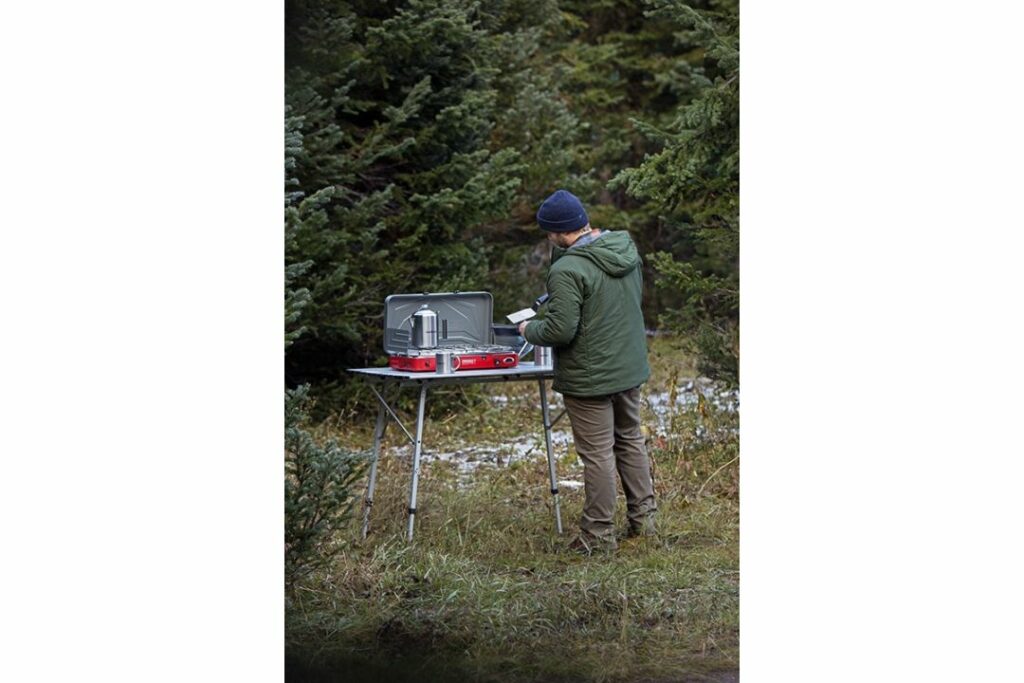
Honorable Mention: Coleman 2-in-1 Grill and Stove
2. Canister Stoves
Moving more into the world of backpacking stoves, canister stoves are often considered the best all-around stoves. Canister stoves are typically small and lightweight, making them ideal for fast and light backpacking trips.
Canister Stoves
Compact and lightweight, canister stoves are a popular choice for solo backpackers.
There are minimal components, which allows you to enjoy some extra space in your backpack!
Unlike the front-country propane camping stoves above, canister stoves will not be very useful or efficient if you are planning to cook large quantities of food for a group greater than two people.
Small and Compact
Since they only have a single burner and employ the use of small pressurized isobutane-propane canisters, the design of these stoves caters more to solo backpackers (or a group of two).
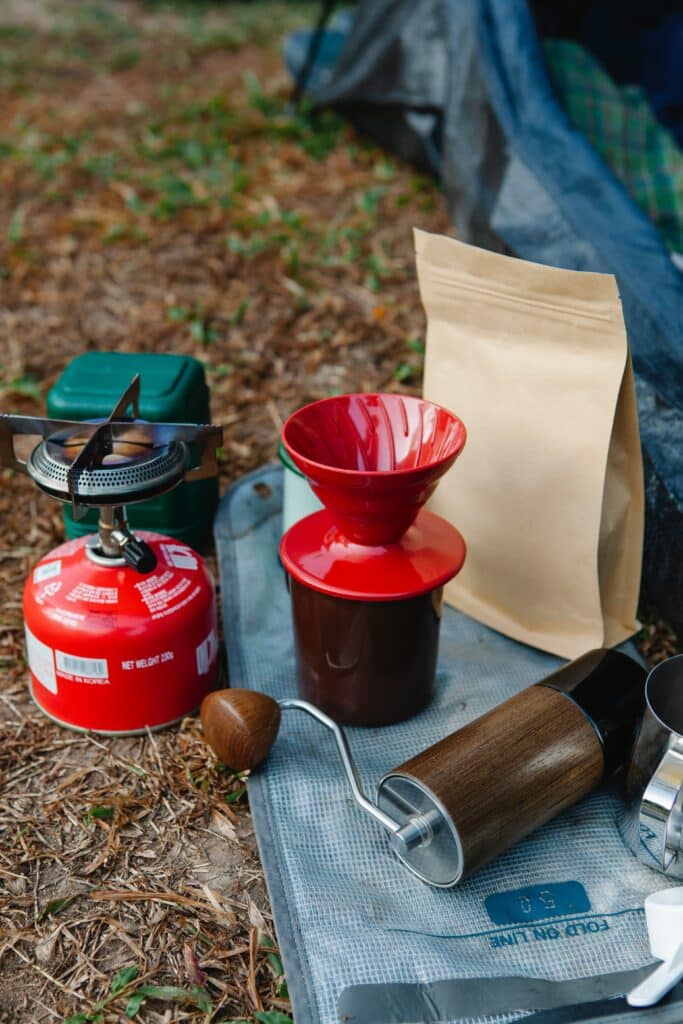
This category of stove is incredibly simple to operate. No priming is required for a canister stove to light; simply turn the valve open and hold a flame over the top of it.
The valve allows the output flame to be controlled easily, which makes simmering an available option. Having the ability to efficiently burn your fuel via the control valve is great for backpackers looking to do more than just boil water.
The “canister stove” category holds a plethora of designs that excel at different things.
For example, integrated canister systems are a burner-pot combo that is attached to each other and have built-in windscreens. This can be a very useful perk, particularly in exposed camping spots like on top of a mountain. Other designs focus more on weighing as little/being as small as possible.
This design has trouble maintaining a steady flame in windy conditions, however, so there are definitely pros and cons to each model.
Difficult to Measure Fuel Level
One downside to using this variety of fuel canisters is the fact that it’s hard to tell how much fuel is left. This can make planning how many canisters to bring on a trip a little difficult.
Not a Good Fit For Winter Temperatures
Due to the contents of these canisters (usually pressurized isobutane-propane blends), they are not ideal for extreme cold. The canisters can depressurize when exposed to extreme temps or elevation, thus producing a weak flame and basically canceling out any efficiency in the system.
Pros of Canister Stoves
- Small and lightweight; minimal components
- Ideal for backpacking trips
- Easy to operate; efficient burning
- Wide variety of models to choose from
Cons of Canister Stoves
- Can’t cook large quantities of food
- Some models are prone to wind disturbance
- Not ideal for extreme cold or high elevation
- Hard to tell how much fuel is left
The Best Canister Stove: MSR Pocket Rocket 2
- Ultralight Camping and Backpacking Stove
- Weight: 2.56 ounces
Honorable Mention: MSR WindBurner Stove System
Personal windproof camping and backpacking stove system
3. Liquid-Fuel
Next up on our list are liquid-fuel stoves. If you haven’t done much backpacking or mountaineering, you may have never heard of these stoves.
While canister stoves run on isobutane blends, liquid-fuel stoves run on white gas. This fuel type performs very well in sub-zero temperatures, as well as costs less than canister blends.
For those who travel internationally often, there are liquid-fuel stove options that allow the use of other fuels such as kerosene and diesel. These fuels are widely available all across the world.
Simply fill up your fuel bottle with the fuel available (it is generally recommended to only use white gas for fuel, when available).
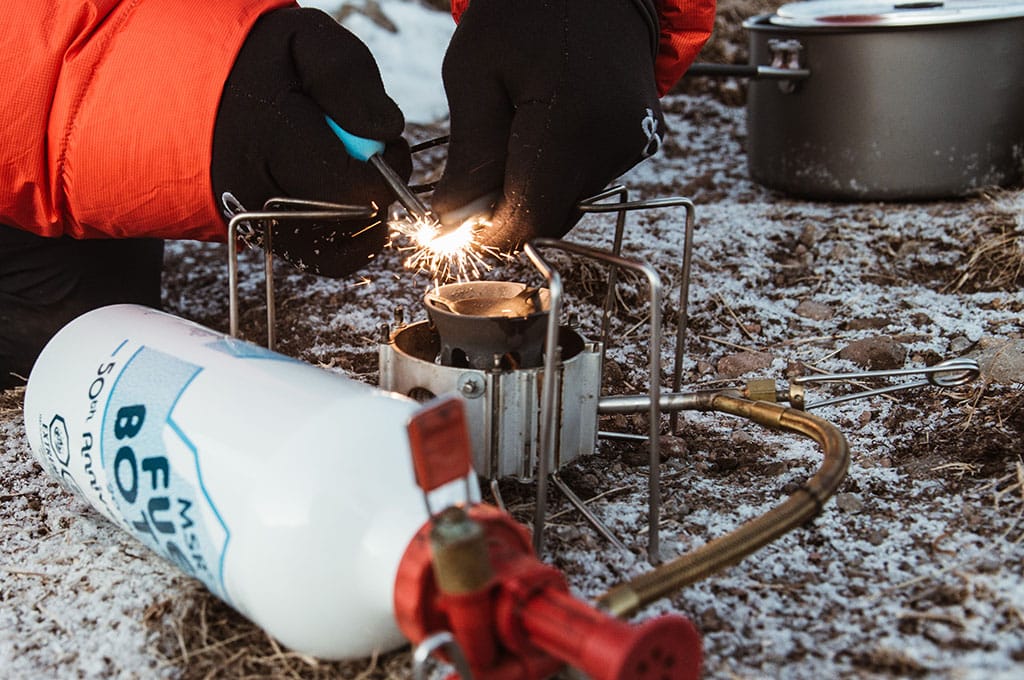
Unlike canister stove systems, it is easy to tell how much fuel you have remaining by just looking into the fuel bottle.
Account for Downsides of Liquid-Fuel Stoves
There are a couple of big downsides to using liquid-fuel stoves.
The first one is that it is necessary to prime your system before use. This task includes pumping your fuel bottle in order to increase pressure for efficient burning. It’s also necessary to preheat the fuel line by allowing a few drips of fuel to run into the priming cup and creating a small flame before fully opening your fuel line.
The second downside is that periodic maintenance is needed if you want your stove to function correctly and last a long time.
Pros of Liquid-Fuel Stoves
- Able to burn multiple fuel types; great for international travel
- Perform well in most conditions (cold and altitude)
- Easy to tell how much fuel is left
Cons of Liquid-Fuel Stoves
- Requires priming and maintenance
- Not as portable as a canister system
- Prone to leaks and spills
The Best Liquid-Fuel Stove: MSR WhisperLite Universal
Compact hybrid fuel camping and backpacking stove
Honorable Mention: MSR XGK EX
4. Wood-Burning Stoves
Growing in popularity in recent years, wood-burning stoves have become a contender for serious backpackers.
Some new models of wood-burning backpacking stoves are incredibly small and lightweight.
Depending on your wants, you can find wood-burning stoves that are made with very few components and can fold up to become flat or even versions that are able to charge your phone or other electronics!
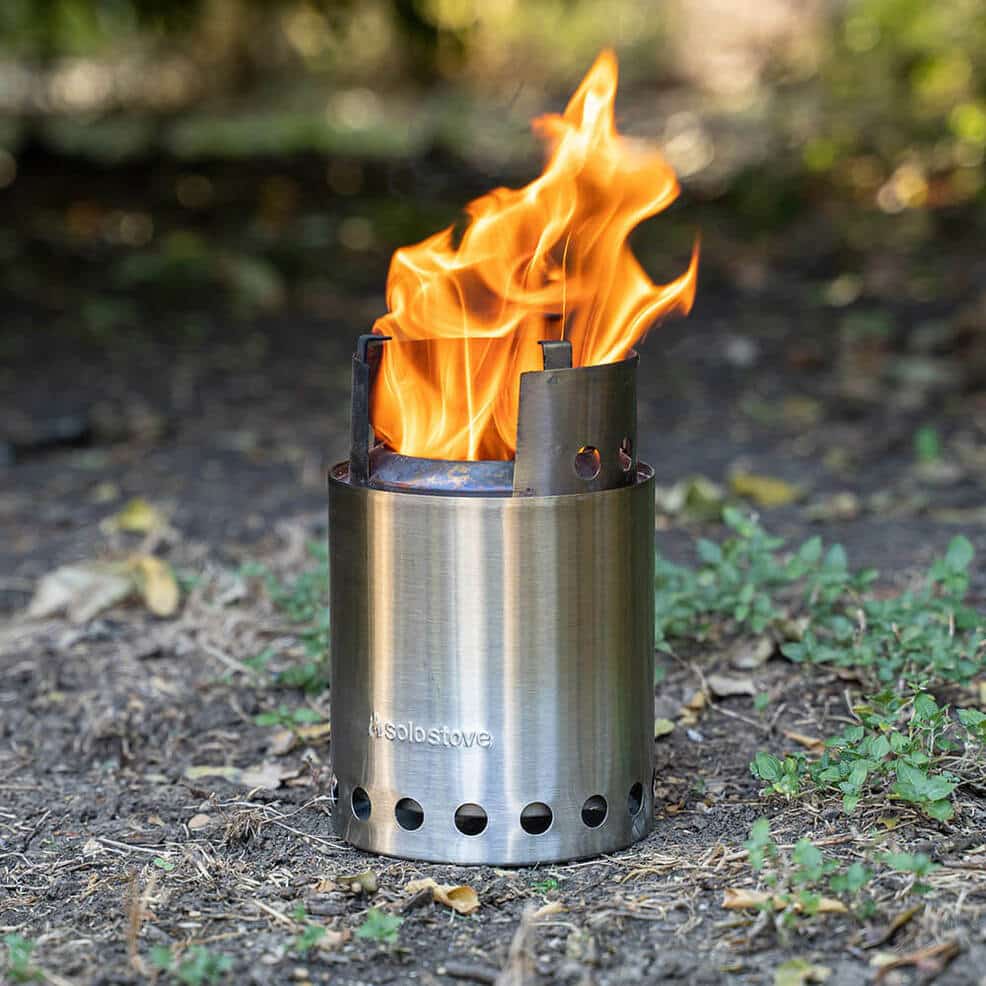
For those who have jumped all in on the wood-burning stove bandwagon, the biggest pro is the ability to burn leaves, twigs, and sticks.
Being able to use gathered resources for fuel instead of lugging along a canister can be a game-changer. Backpackers who have long trips planned in wooded areas may find this variety of stove as their best option.
As with anything this cool, there are naturally a couple of downsides.
If you are relying 100% on your capacity to gather usable fuel, whenever Mother Nature strikes in the form of torrential downpours, you may be screwed (for a little while). It’s also vital to keep burn bans in mind.
Make sure you are following all local guidelines when it comes to burning.
Pros of Wood Burning Stoves
- Can be small and lightweight
- Ability to burn leaves and sticks
- Not always necessary to carry fuel
Cons of Wood Burning Stoves
- May be hard to find fuel in wet conditions
- Falls under burn ban guidelines
The Best Wood Burning Stove: Solo Stove Lite
Portable camping and hiking stove. This powerful and efficient wood burning stove emits low levels of smoke and has a quick boil rate. Weighs approximately 9.6 ounces.
Honorable Mention: Vargo Titanium Hexagon Wood Stove
Collapsible and portable wood burning stove. Weighs approximately 2.6 pounds.
5. Alcohol Stoves
Denatured alcohol stoves are some of the cheapest, smallest, and most lightweight stoves out there. It is very popular among ultralight thru-hikers for these reasons.
Lightweight and Low Maintenance
Having a stove that only weighs a couple of ounces makes a big difference when a hiker is covering 20-30 miles a day. Alcohol stoves are also very simple; it is rarely necessary to perform maintenance or fix some components of an alcohol stove.
Denatured alcohol stoves run on, you guessed it, denatured alcohol.
This fuel type is common in the U.S. and fairly cheap. When backpacking with an alcohol stove, carry a bottle of denatured alcohol that is sized to the needs of your trip.
With experience, it’s possible to figure out exactly how much fuel is needed for a trip, allowing the hiker to save weight and space in a backpack.
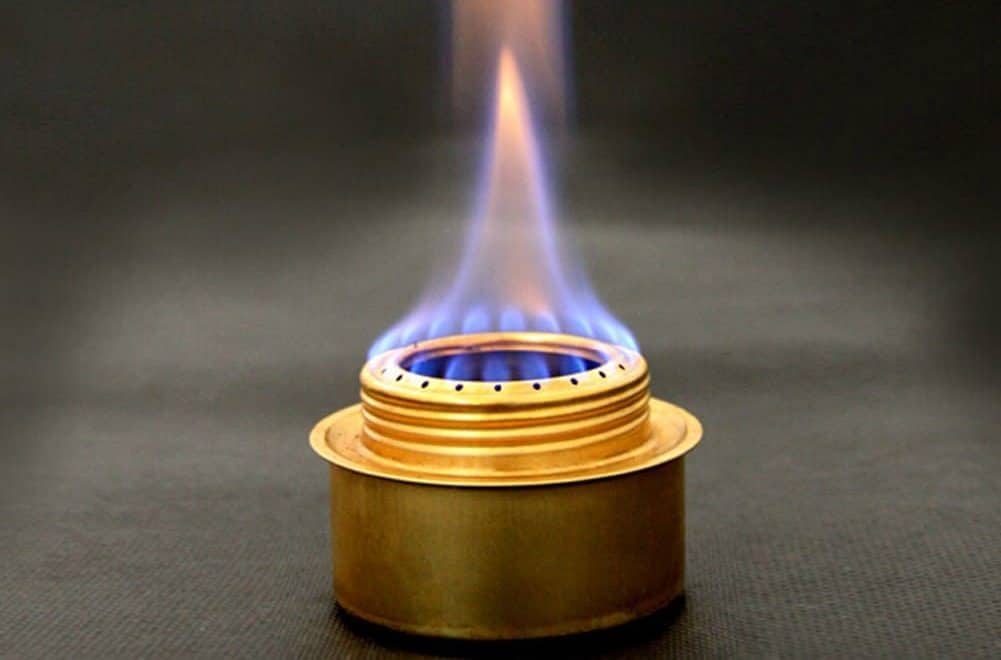
Longer Time to Boil Water
It does take quite a bit longer to boil water on an alcohol stove than on a heavier and bulkier canister stove due to the heat produced by an alcohol flame. But if you’re willing to sacrifice some time, it is worth it in the long run.
Quiet Burn
On the plus side of burning denatured alcohol, it burns very quietly. This can be great if the idea of a noisy isobutane-fueled flame doesn’t float your boat.
Alcohol stoves are, however, prone to wind disturbance. Making or finding a windscreen that works for your stove of choice is a good idea when camping in wind-prone areas.
Pros
- Incredibly small and lightweight; popular with thru-hikers
- Only necessary to carry one bottle of denatured alcohol that is sized to your trip’s needs
- Burn very quietly
Cons
- Burn much slower than liquid or canister stoves
- Prone to wind disturbance
- Takes longer to boil water
The Best Alcohol Stove: TOAKS Titanium Siphon
Honorable Mention: Trangia Spirit Burner
6. Solid-Fuel Tablet Stoves
Another popular choice for ultralight backpackers is solid-fuel tablet stoves.
Ultra Lightweight and Compact
Employing the use of solid-fuel tablets such as ESBIT, these stoves are also incredibly lightweight and small in construction. Some models are so compact that you can slip them into your pants pocket.
If that’s not compact for a camping stove, then I don’t know what is.
Inexpensive
This category of stove is also among the cheapest options available for an avid backpacker. For someone new to the ultralight backpacking scene, solid-fuel tablet stoves provide a low barrier of entry.
Easy to Ignite
These stove use tablets that light very quickly and easily. If you don’t need to use a full tablet for a session of cooking, simply extinguish the tablet and save the rest to use for later. The tablets themselves are usually fairly priced.
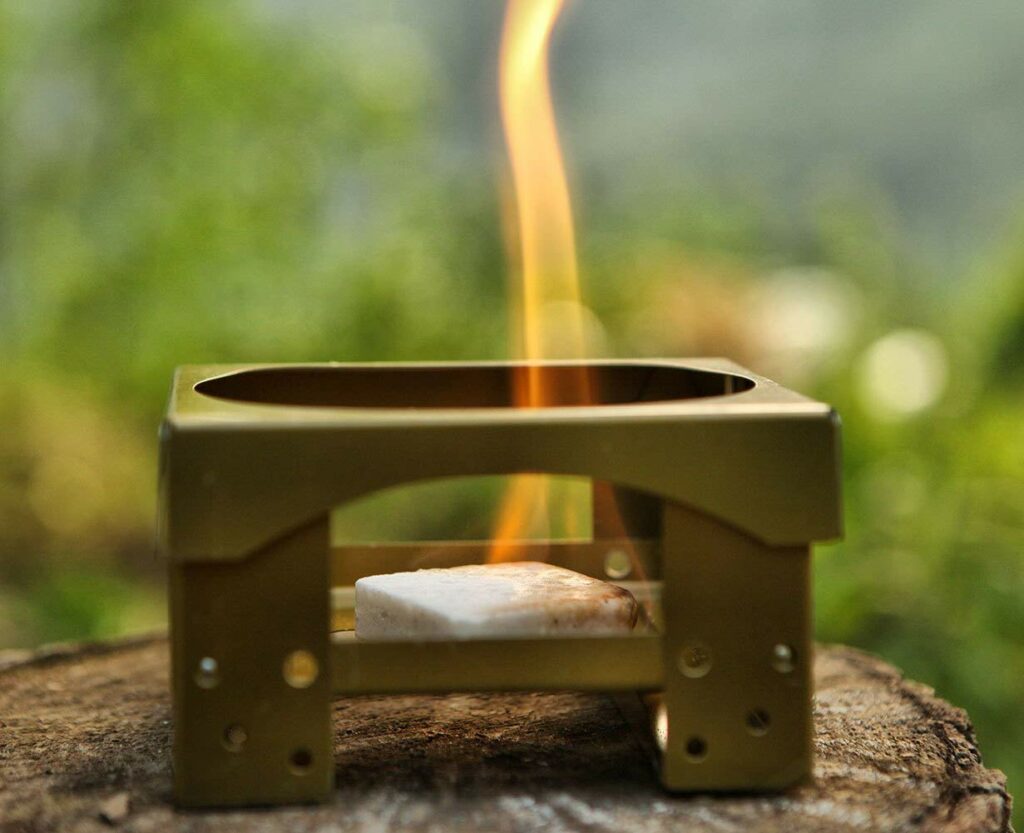
Like the alcohol stoves above, these solid-fuel stoves take a while to boil water due to the heat produced. Again, this is an inconvenience undertaken for the convenience of a super lightweight and compact stove.
A common complaint about solid-fuel tablet stoves is the strange smell produced by the tablets. Many users state that a strong fishy smell is given off by the tablets, even when not burning. This can be a huge turnoff for someone considering a solid-fuel purchase.
Pros of Tablet Stoves
- Tablets light quickly and easily
- Another popular choice for thru-hikers due to their small size and weight
- Inexpensive and compact
Cons of Tablet Stoves
- Tablets often produce a strange smell
- Burn much slower than liquid or canister stoves
The Best Solid-Fuel Tablet Stove: Esbit Pocket Stove
- Weighs less than 0.2 grams
- Easily folds and small enough to fit in a pocket
- One fuel tablet will boil 500ml of water in about 8 minutes
Honorable Mention: Esbit Alcohol Stove & Trekking Cookset
Brass alcohol burner stove
Includes 2 Anodized Aluminum Pots
What is Your Favorite Camping and Backpacking Stove?
Let us know about your favorite stove to pack and use on backpacking adventures. We love to learn more through the feedback of our audience of outdoor enthusiasts. Please provide your comments below.
To read more about how to choose camping equipment, check out my article all about selecting your ideal sleeping bag, and another about the top sleeping pads.
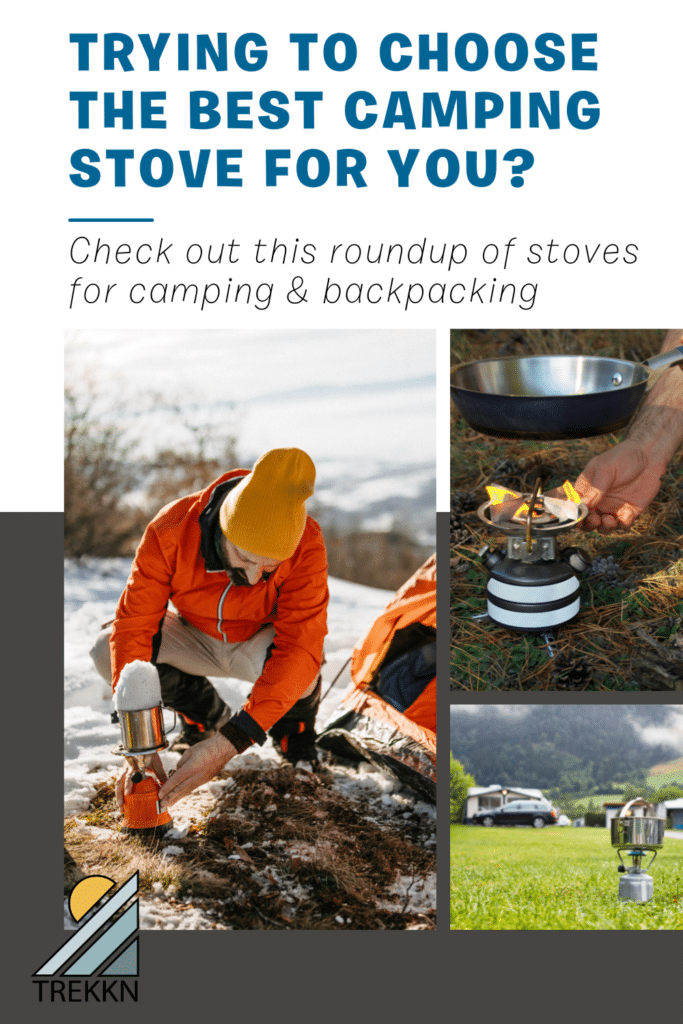

Josiah B gained invaluable experience while living on the road with his family, during which time he felt overcome with the desire to continue exploring. That search landed him in Seward, Alaska, where he currently resides. His love for the outdoors is welcome with open arms in the Last Frontier, and with an endless amount of hiking and backpacking to be done, he’s eager to share the best that Alaska has to offer.


